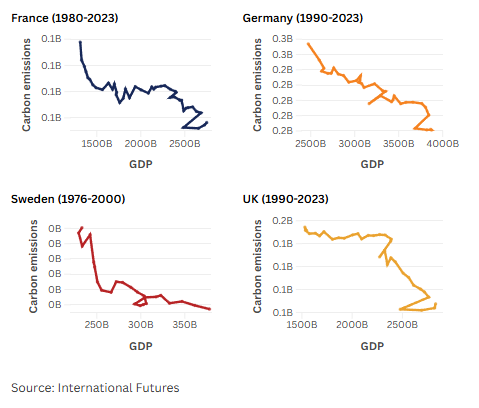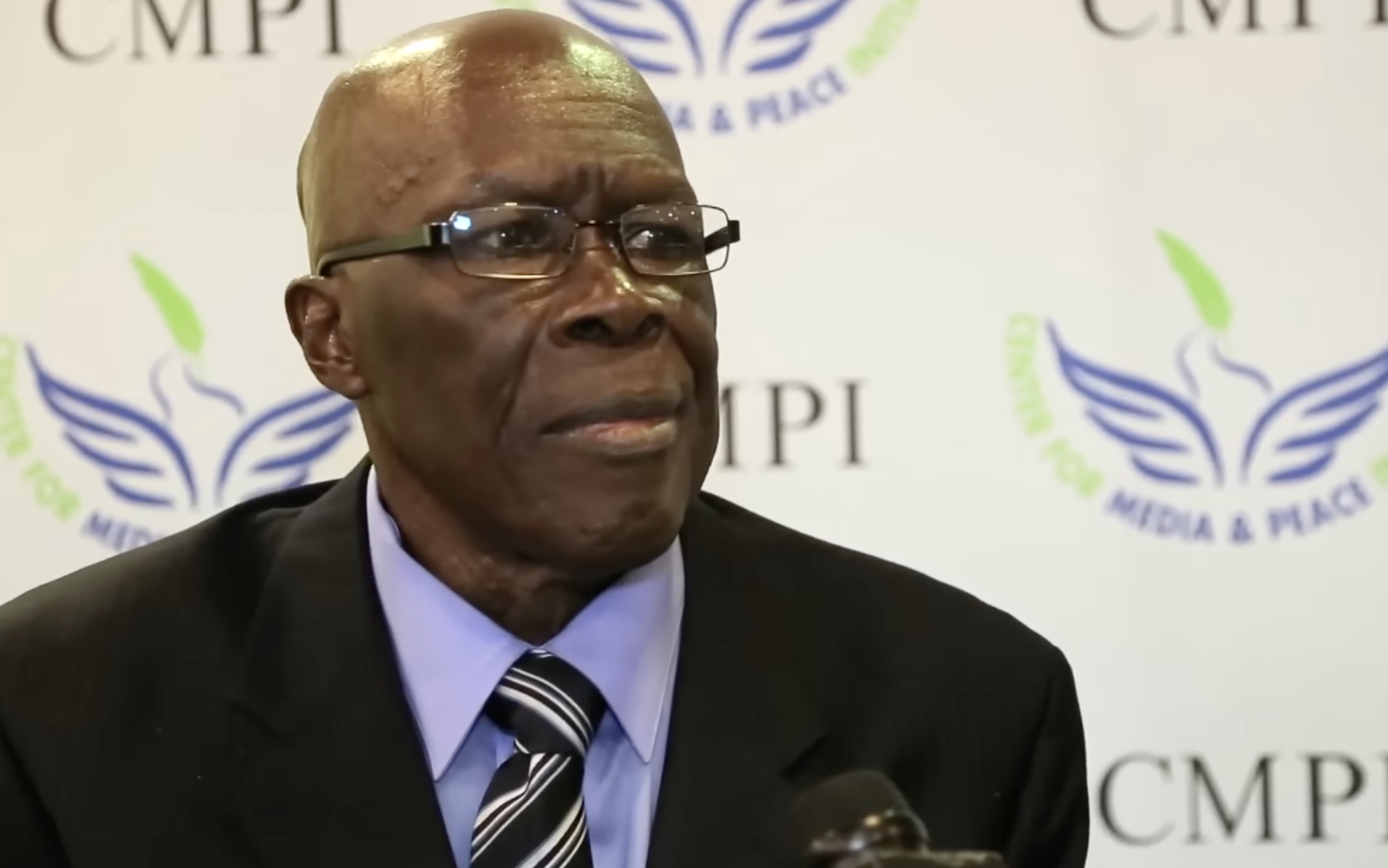Africa's Decarbonisation Dilemma
Without enough capital or enabling global policy, expecting Africa to decouple economic growth from carbon emissions is a pipe dream. Alize le Roux, Senior Researcher, African Futures and Innovation, , offers insights into this global dilemma.
Since the First Industrial Revolution, economic growth has been coupled with increasing carbon emissions. The United Kingdom (UK), Germany and United States relied on coal, oil and natural gas to become high-income economies – a carbon-intensive process widely acknowledged as the current climate crisis.
In contrast, Africa contributes a 4-5% of global emissions. Yet it is expected to lift half a billion people out of provide energy access to 640 million , and develop rapidly without relying on the same resources that powered the prosperity of today’s wealthy nations.
This stark imbalance is evident in historical emissions data (see graph). High-income countries caused most fossil fuel emissions throughout the 20th century, peaking at over four billion tonnes annually by the 2000s. Emissions from low-income countries (including most of Africa) remained negligible.
Today, emissions growth is driven by upper-middle-income economies like China, which from 1980 to 2020 saw its gross domestic product grow 35-fold and emissions surge from 0.4 billion to three billion tonnes. This fossil-fuel-powered industrialisation 800 million people from poverty, massively expanding the country’s carbon footprint.
Total carbon emissions from fossil fuel consumption and cement production

Tons of carbon emissions by global income group, 1960-2030
The UK, US, France and Germany followed the same path decades earlier, using the same fossil fuels to grow their economies, ingraining the carbon-heavy development model they are now working to reform. Today, these countries are flattening the curve and even decoupling their economies from carbon emissions using the wealth and institutional capital accumulated over centuries to invest in clean energy.
But Africa is expected to leapfrog straight to low-carbon development without the infrastructure, capital or policy space enjoyed by those who created the mess.
While transitioning to clean energy is necessary, Africa’s outdated power infrastructure and widespread deficits make it difficult. In most countries, the building blocks of a modern energy system – from reliable grids to storage and transmission – are absent or underdeveloped.
Africa must grow, and emissions will inevitably rise as a result. This is why the African Union and African Group of Negotiators the Common African Position (CAP) on Climate Change in 2023. It is one of the continent’s few political instruments collectively negotiated, and asserts Africa’s rights in the global climate agenda.
The CAP affirms Africa’s right to development and energy access using a balance of renewables and non-renewables. It calls for fair global mitigation expectations, increased grant-based climate finance, and access to low-carbon technologies.
It is not a plea for exemption but a pragmatic demand for equity grounded in emission facts. The CAP can serve as a key bargaining platform for global carbon finance reform and technology transfer, but requires greater political and visibility within Africa – beyond United Nations Climate Change Conferences.
Even under the most optimistic low-carbon scenarios, Africa’s emissions are projected to double over the next two decades. This is a sign not of policy failure but economic necessity. To avoid this outcome, Africa needs technological and financial support on a scale never seen before, and current climate finance frameworks are not delivering.
The ambition to decouple economic growth from emissions is possible – as shown by 49 , mostly in Europe and high-income economies. France, Germany, Sweden and the UK are good examples of clean energy growth (see graph). For Germany, intermittent renewable energy supply meant an increased reliance on electricity imports, particularly from France, with its stable nuclear-powered grid.
GDP measured in market exchange rates and carbon emissions measured in tons of carbon
A key lesson from Europe’s energy transition, alongside significant funding, is regional interdependence as countries leverage each other’s strengths to maintain grid reliability while decarbonising.
Another commonality among decoupled countries is their investment in context-specific technologies – France through nuclear, the UK through offshore wind, and Sweden through its hydropower and nuclear mix. The switch to clean energy was tailored to available resources, with natural gas as the cornerstone of the transition.
Each decoupled economy had a foundation of public investment, skilled negotiators and strong institutions. These countries all adopted a form of carbon pricing mechanisms, phased out coal by incentivising early adoption of clean technologies, and invested in grid infrastructure. They backed these efforts with long-term regulatory frameworks and investor guarantees – essential to unlock private capital and build trust in the transition.
In Africa, South Africa and Morocco are early examples of countries entering their decoupling phase. South Africa’s Just Energy Transition Partnership (JETP), with its initial pledge of US$8.5 billion in concessional funding, represents one of the first national transitions backed by international and domestic planning.
Even under the most optimistic scenarios, Africa’s emissions are projected to double over the next two decades
Morocco has demonstrated the power of early public investment combined with international diplomacy. It has developed one of the world’s largest concentrated solar power facilities and significantly expanded its wind, solar and hydro capacity over the past decade. Progress has been underpinned by sustained public finance, robust policy direction and diplomatic engagement.
Unlike these two countries, most of Africa has limited electrification, sparse grids, poor infrastructure, weak industrial bases and constrained institutions. While renewables are increasingly cost-effective and are being deployed quickly, they cannot meet Africa’s baseload energy needs or power the industrialisation needed to end widespread poverty. Higher-density energy sources, like natural gas, and where feasible, nuclear, must join the energy mix.
For Africa, leapfrogging to a low-carbon future without adequate capital or enabling global policy frameworks is unrealistic.
Foreign investment remains volatile, and nearly two-thirds of climate-related official development assistance to Africa in 2022 were concessional , not grants, adding to the continent’s rising debt burden. A global carbon tax has been as a funding mechanism, but a binding global effort is unlikely in the current geopolitical climate.
Africa needs tech and financial support on a scale never seen before, and current climate frameworks aren’t delivering
At a minimum, the G20 should implement a carbon price floor targeted at the world’s highest emitters, with a share directed to low-income, low-emission, energy-poor countries. A pragmatic African decoupled pathway demands systemic reform of the global financial architecture. Climate finance must shift from debt-based loans to unconditional grants for low-income countries.
The idea of scaling up South Africa’s JETP model across the continent has been raised, highlighting the need for a continent-wide investment platform to coordinate and de-risk capital flows. But Africa must also demonstrate leadership. No investor will commit to unstable environments, so governance reform, regulatory clarity and political stability are non-negotiable.
None of this is possible without delinking climate finance from debt. Africa did the least to cause the climate crisis, yet is expected to pay the most for solving it.
Without global finance reform, structured external support and strong continental leadership, Africa will face a stark choice: remain locked in energy poverty for decades to come, or repeat the fossil-fuel-intensive path that created the climate crisis in the first place.
This article was published in Africa Today, the blog of the ISS African Futures and Innovation programme. This article was republished by Infrastructure News from ISS Today











